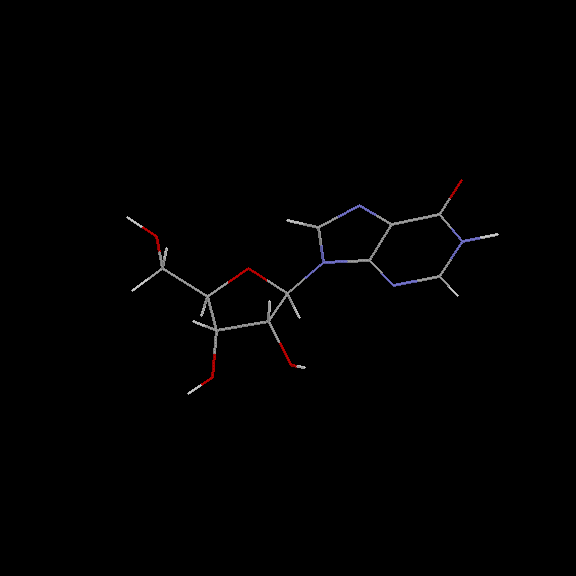Inosine
Inosine, a nucleoside characterized by the association of hypoxanthine and ribose through a β-N glycosidic bond, serves as a key constituent in various nucleic acid structures. Notably, inosine demonstrates its capacity to engage in wobble base pairings with adenine (A), cytosine (C), and uracil (U), thereby contributing to the functional flexibility and adaptability of nucleic acid sequences. This unique capability to participate in wobble base pairings highlights the dynamic nature of inosine and its role in promoting structural diversity and functional versatility within genetic coding.
Moreover, beyond its role in nucleic acid structure, inosine assumes significance in the de novo synthesis of purine-based nucleotides, thereby contributing to the intricate process of nucleotide biosynthesis. This involvement underscores the critical role of inosine in the broader landscape of cellular metabolism, emphasizing its indispensability in the synthesis of crucial biomolecules essential for cellular function and genetic stability.
Accession Number : KLM0000238 This work is released into the public domain; please see our release statement.
Doug Markham has contributed a molecular mechanics computation of the structure! See below for the details.

Config Rule :
% inosine
config(inosine,[
substituent(hypoxanthinyl),
substituent('D-1-dehydroxy-ribofuranosyl'),
linkage(from('D-1-dehydroxy-ribofuranosyl',car(1)),
to(hypoxanthinyl,nit(9)),
up,single)]).
config('D-1-dehydroxy-ribofuranosyl',[
ring([
oxy,
anomeric(1,hyd),
car(2,hyd&&hydroxyl;),
car(3,hyd&&hydroxyl;),
car(4,hydroxymethyl&&hyd;)])]).
config(hypoxanthinyl,[
model(hypoxanthine,[
diff(nit(9,hyd),nit(9))])]).
config(hypoxanthine,[
model(purine,[
diff(nit(1),nit(1,hyd)),
diff(car(6,hyd),car(6,oxy?))])]).
config(purine,[
ring_system([
ring([
car(6,hyd)&,
car(5)&,
car(4)&,
nit(3)&,
car(2,hyd)&,
nit(1)&]),
ring([
nit(7)&,
car(8,hyd)&,
nit(9,hyd)&,
car(4)&,
car(5)&])],
conjugate(1,pseudopos([car(4),car(5)]),2,pseudopos([car(4),car(5)]))])]).
Smiles String :
[C@2H]-1([O][C@2H]([C@2H]([OH])[C@2H]-1[OH])[C@2H2][OH])-[n]1([cH][n][c]2([c]1[_ n][cH][nH][c]2[O-])) inosine
Terminal :
% inosine
c(1,12,(0,chiral))-[c(2,left)~,o(1,right)~,n(9,up)~,h(1,down)~],
c(2,12,(0,chiral))-[c(3,left)~,c(1,right)~,h(2,up)~,o(2,down)~],
c(3,12,(0,chiral))-[c(4,left)~,c(2,right)~,h(4,up)~,o(3,down)~],
c(4,12,(0,chiral))-[o(1,left)~,c(3,right)~,c(5,up)~,h(6,down)~],
c(5,12,(0,nonchiral))-[h(7,left)~,h(8,right)~,o(4,up)~,c(4,down)~],
c(6,12,(0,nonchiral))-[h(10,nil)~,n(3,flat)&,n(1,flat)&],
c(8,12,(0,nonchiral))-[n(3,flat)&,c(9,flat)&,n(9,flat)&],
c(9,12,(0,nonchiral))-[c(8,flat)&,c(10,flat)&,n(7,flat)&],
c(10,12,(0,nonchiral))-[o(5,nil)?,n(1,flat)&,c(9,flat)&],
c(12,12,(0,nonchiral))-[h(12,nil)~,n(7,flat)&,n(9,flat)&],
h(1,1,(0,nonchiral))-[c(1,up)~],
h(2,1,(0,nonchiral))-[c(2,down)~],
h(3,1,(0,nonchiral))-[o(2,nil)~],
h(4,1,(0,nonchiral))-[c(3,down)~],
h(5,1,(0,nonchiral))-[o(3,nil)~],
h(6,1,(0,nonchiral))-[c(4,up)~],
h(7,1,(0,nonchiral))-[c(5,right)~],
h(8,1,(0,nonchiral))-[c(5,left)~],
h(9,1,(0,nonchiral))-[o(4,nil)~],
h(10,1,(0,nonchiral))-[c(6,nil)~],
h(11,1,(0,nonchiral))-[n(1,nil)~],
h(12,1,(0,nonchiral))-[c(12,nil)~],
n(1,14,(0,nonchiral))-[h(11,nil)~,c(6,flat)&,c(10,flat)&],
n(3,14,(0,nonchiral))-[c(6,flat)&,c(8,flat)&],
n(7,14,(0,nonchiral))-[c(9,flat)&,c(12,flat)&],
n(9,14,(0,nonchiral))-[c(1,down)~,c(12,flat)&,c(8,flat)&],
o(1,16,(0,nonchiral))-[c(1,left)~,c(4,right)~],
o(2,16,(0,nonchiral))-[h(3,nil)~,c(2,up)~],
o(3,16,(0,nonchiral))-[h(5,nil)~,c(3,up)~],
o(4,16,(0,nonchiral))-[h(9,nil)~,c(5,down)~],
o(5,16,(0,nonchiral))-[c(10,nil)?]
The Terminals for all the Config Rules are in Prolog Definite Clause Grammar (DCG) form.They can be checked in the Manual here.
The compound's PDB file can be seen here.
Doug Markham of the Institute for Cancer Research, Fox Chase Cancer Center,Philadelphia, PA, has contributed the following structure for inosine. He computed this structure in sdf format using MacroModel, a molecular mechanics program. We have used Babel to convert the .sdf format to PDB format. You'll find it interesting to compare these structures to those computed using CONCORD.
Many thanks Doug!
